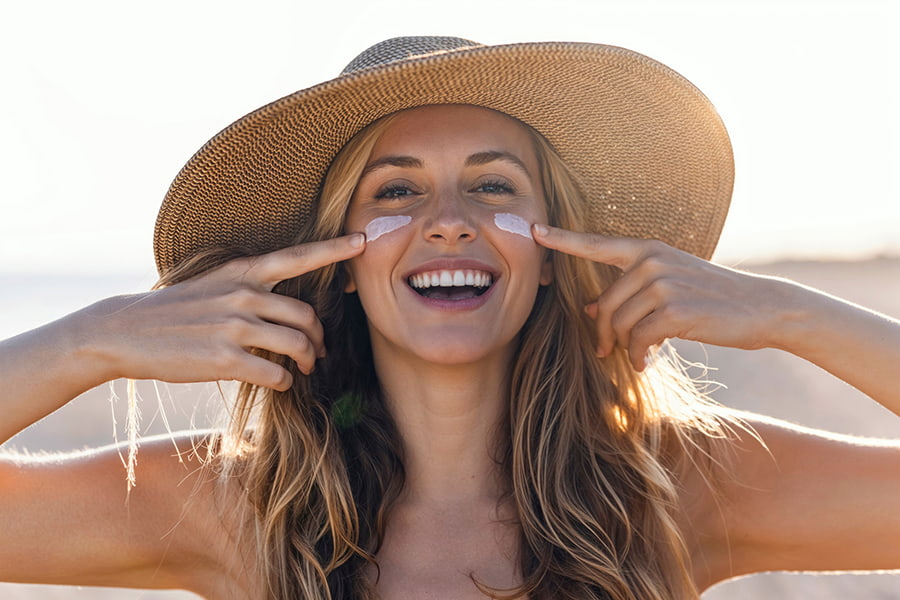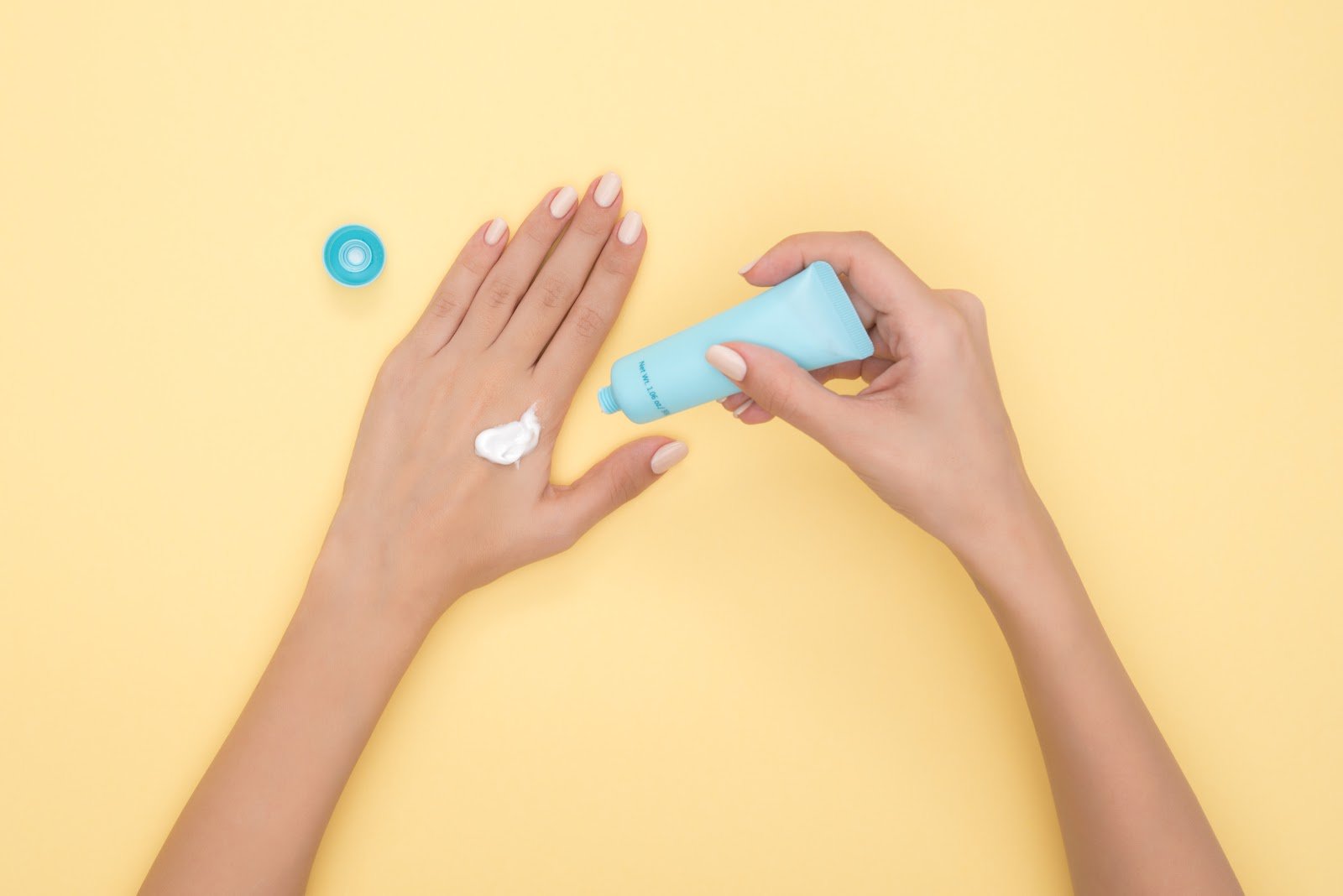










Summer's almost here, and you know what that means - time to hit the beach and enjoy some much-needed vacation time with friends and family!
As fun as these upcoming months can be, it's important that you take a little extra time to protect your skin from the sun's harmful UV rays. But what type of sunscreen should you use, and how often should you use it? What else can you do?
No one wants to look a year older in just 3 short months simply because they didn't take a few minutes to apply sunscreen each day. In our updated 2019 guide to summer sun protection, you'll learn all of the best ways to prevent skin cancer and slow aging caused by sun exposure.

Almost everyone's dealt with a painful sunburn at some point - what's the big deal? Isn't that just a normal part of summer?
If you think that a sunburn is "no big deal," here are some pretty sobering facts you should know.
And if the medical facts don't worry you, let's not forget that sun exposure causes your skin to age more rapidly, making you look much older than you really are.
Whatever your reason for wanting to learn about effective summer sun protection methods, you're taking a step in the right direction. The sooner we start being proactive about sun protection, the better, and it's never too late to start!
So without further ado, here are 11 skin care tips that will help you have a safe, fun and sunburn-free summer.
If you only think about applying sunscreen when you're wearing a swimsuit, you need to be thinking about it more often.
While it's true that being near reflective surfaces like water, sand, and even snow increase your exposure to UV rays, these cancer-causing rays are harmful no matter what you're doing outdoors.
So while you might always remember to use sunscreen before going to the beach or the pool, don't forget to use it before doing these other summer activities, too:
You know that wearing sunscreen is important, but is the product you're currently using really doing its job?
The truth is, not every brand of sunblock is effective, even if they have a high SPF. That's because SPF only measures a sunscreen's ability to block UVB rays, not UVA rays. UVA rays don't cause sunburn, but they do increase your risk of skin cancer and speed up the aging process, making them just as harmful.
To block both UVB and UVA rays, choose a sunscreen with broad-spectrum protection and an SPF rating of at least 30. If you're curious about the difference between chemical and physical sunblock, check out our comparison guide.
You would think that a 50 SPF sunscreen would offer better protection than a 15 SPF product, but that isn't necessarily the case.
A product's SPF number tells you how much longer it will take for your skin to turn red than if you weren't wearing any sunscreen at all. So if you're wearing 30 SPF, it will take 30 times longer for your skin to turn red than if you weren't wearing it.
Here's the catch - while a higher SPF does offer better protection, it also tends to give people a false sense of safety. Someone wearing SPF 50 sunblock may feel like they can stay outside longer without reapplying, or they may not even reapply at all. No matter what SPF you use, be sure to use it as directed.
Choosing the right sunscreen is important, but so is the way you apply it. Some areas are obvious - most of us do a pretty good job of covering our arms, legs, shoulders, stomach and back. But there are also areas you might forget about, such as:
Coincidentally, the busiest time for pools and beaches also happens to be the worst time to be out in the sun - between the hours of 10 am and 2 pm.
By planning your summer outings in the mornings and evenings, you can avoid the crowds and avoid the strongest UV rays at the same time. When you do go out in the late morning or early afternoon, use caution - try to stay in the shade as much as possible and take advantage of the summer sun protection tips in this blog.
Sunscreen isn't a "one and done" kind of deal - you have to keep reapplying it so that it remains effective for as long as you're outdoors.
If you're using a 30 SPF product, it's recommended that you reapply every two hours for the best results. If you've worked up a sweat or gotten wet after using sunscreen, it's best to reapply it right away (even if the bottle says "water resistant" or even "waterproof").
If you're the type of person who's always forgetting to apply and reapply sunscreen, wearing protective clothing when you're out in the sun is an easy and fashionable way to keep your skin safe from harm. That being said, it's still a good idea to apply sunscreen no matter what you're wearing.
More brands are launching UPF (Ultraviolet Protection Factor) clothing lines that use special UV-blocking fabrics. UPF measures the fraction of radiation that's able to penetrate clothing - so for example, a t-shirt that's UPF 30 will only allow 1/30th of the sun's radiation (both UVB and UVA) to reach the skin.
In addition to UPF clothing, the Skin Cancer Foundation also recommends wearing a wide-brimmed hat (ball caps leave the ears uncovered) and UV-blocking sunglasses when you're out in the summer sun for maximum protection. Sunglasses have the added benefit of helping to postpone cataracts.
Drinking water has a long list of health benefits, but did you know that staying hydrated can also help to protect your skin from sun damage? No, drinking water alone will not prevent sunburn, but it can help to replace the moisture your skin loses due to sun exposure.
Also, it should go without saying that alcoholic drinks are not hydrating. Stick to water and drinks with electrolytes (Gatorade, Powerade) instead.
After a long day out in the sun, you're probably feeling parched - well, so is your skin! Moisturizing your skin after sun exposure can help to soothe inflammation and prevent any further damage from UVA and UVB rays.
Look for after-sun skin care products with ingredients like aloe vera, oat, and ceramides. Avoid gritty and abrasive products like body scrubs - these can irritate skin that has become sensitive due to sun exposure.
Summer sun protection isn't just about what you put on your body - what you put into your body matters too. Eating plenty of fruits and vegetables that are rich in antioxidants can help protect your skin cells from the sun's UV rays and reduce the cellular and subcellular damage that occurs.
Examples of antioxidant-rich foods include carrots, grapes, green tea, blueberries, spinach, tomatoes, and watermelon.
While a healthy diet can go a long way to prevent sunburn, wrinkles, and even skin cancer, it should still be paired with daily sunscreen use.
With all this talk of the dangers of sun exposure, you might think that tanning indoors is a perfectly safe alternative - well, think again.
The truth is, you are actually more likely to develop skin cancer from using tanning beds than you are to develop lung cancer from smoking.
Indoor tanning is anything but a safe alternative to getting that perfect bronze glow for summer. If you want a tan that badly, use spray tans and mists approved by the FDA instead.
With so much evidence linking sun exposure with skin cancer and faster aging, it's surprising that most Americans don't use sunscreen. Maybe it's because we tend to see sunscreen as something of a nuisance - who would actually put something so greasy and strong-smelling on their skin every day?
But most modern sunscreen formulas aren't like that at all. In fact, many of them even offer additional benefits, like moisturized and glowing skin. With the right product, applying sunscreen will start to feel more like a luxury and less like a chore.
If you're itching to find out what the best summer sun protection lotion or spray is the best on the market in 2019, dermatologists agree on this - the best sunscreen is one that you'll actually use every day.
Prevention is key. By making sun protection a part of your daily life, you can greatly reduce your risk of skin cancer. You can even slow the hands of time and keep your skin looking young and wrinkle-free for much longer!
Even at the end of a well-protected summer, there may still be some damage. Treating the pigment changes that occur from sun exposure can be accomplished at Farrior Facial Plastic Surgery with a superficial chemical peel or Intense Pulsed Light (IPL). Botox will soften the wrinkles that may have become deeper over the summer.
Now that you know how to protect your skin, there's no excuse not to. So go out and make this summer fun and safe for you and your loved ones by putting a little extra care into your skincare routine.
Dr. Farrior is so much more than a doctor – he’s an artist. Dr. Farrior has the right medical knowledge and the artistic vision needed to create harmony among his patients’ facial features. He truly listens to his patients and is always open to their concerns.